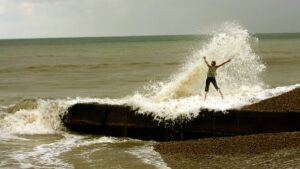How this copper explorer plans to reinvigorate WA’s Wheatbelt

Pic: Schroptschop / E+ via Getty Images
Special Report: Caravel Minerals (ASX:CVV) has one of the largest copper projects in Australia and it is winning support in Western Australia’s Central Wheatbelt.
The company’s namesake Caravel project is the largest copper resource in Western Australia – at over 660 million tonnes of ore for about 1.89 million tonnes of copper and expected to increase further.
The Project’s indicated and inferred resource – 366 million tonnes grading 0.35 per cent copper – incorporates more than a decade of drilling data and now has the potential to become a large-scale, long-life, low-cost copper producer.
As well as the very large resource, one of Caravel’s biggest advantages is the project location, only 150km north of Perth, Western Australia – a stable mining jurisdiction. The project is 12km south-west of the Wheatbelt town of Wongan Hills, with excellent access to infrastructure, such as grid power, roads, rail and services.
Caravel also has the option of three ports – Geraldton, Fremantle or Bunbury – for export of the copper concentrate products.
>> Learn more about Caravel Minerals
Another advantage of its location is that the project is being developed at a time when farming employment numbers in Western Australia’s Central Wheatbelt are declining, partly as a result of the automation of the industry and the increasing scale of farming operations, so the regional areas are looking for new industries to boost employment.
“We’ve been working with the farmers to carry out all of our exploration work over a number of years and have received very good support from them,” project study manager Steve Abbott told Stockhead.
“The area has a proud farming history, but presently the populations and the towns are declining, particularly around the age groups of 20 to 40-year-olds. A mining project could bring that sort of demographic back into the region and diversify the economy.”
Mammoth deposit
Based on the current resource, the Caravel project would have an initial life of more than 30 years, with plenty more upside for expansion.
Caravel is a porphyry deposit, which means it is hosted in a type of granite rock, the same as most of the major copper deposits around the world, although the rocks at Caravel are much older than most other porphyry deposits and it was never expected to find a deposit like this in this region. Modern examples of these deposits are hosted in the mountain ranges like the Andes which are similar to the mountains that once existed in the Wheatbelt but almost 3 billion years ago.
Porphyry deposits are usually large and low-grade but can be mined at low cost due to their scale. Globally, over 60 per cent of copper, all of the world’s molybdenum, 10-15 per cent of uranium and a significant amount of gold comes from porphyry deposits.
The discovery of the Caravel project has highlighted the potential of what was previously a very unexplored region. The ancient landscape of Australia with weathering over millions of years has masked Caravel’s resources below the surface layers of sand, gravel and clay. The difficulty of finding minerals below this weathered layer, which is often 50m thick, has meant there has been very little exploration in the Wheatbelt region.
Dominion Mining, one of the first explorers in the region, undertook a major programme of soil testing thought the Wheatbelt and South West over the last decade, locating the anomalies that pointed to gold initially and then led to the discovery of copper at what is now the Caravel Copper Project.
Caravel is a similar age and related style to the well-known Boddington gold mine that has been producing for a decade now and is one of Australia’s largest producing gold mines.
Boddington produces gold as well as a copper concentrate, though the copper grades are lower than Caravel and gold is the main source of revenue.
Abbott said that the metallurgical test work shows it has very favourable metallurgical characteristics and high recoveries.
Recent test work indicates Caravel can achieve rougher recoveries averaging 96.1 per cent by using conventional, low cost processing and a high grade copper concentrate can be produced at a high recovery.
The results have exceeded the company’s expectations with very fast float times, very low reagent use and very good recoveries.
“It’s amenable to conventional processing techniques and we’ve got some very good results from the testwork undertaken to date. It’s a relatively simple process that has been well proven elsewhere,” Abbott said. “It will aim to be a low-cost project both from a capital and an operating cost point of view.”
Caravel is firming the production and cost metrics in an updated scoping study that is due to be released in early May.
The updated study is the culmination of 10-12 months of work.
Increasing confidence
Caravel is de-risking many other aspects of its project which has provided greater certainty to plan for the deposit’s development.
“Certainly, the work that’s been done has given us good confidence that there are no show stoppers,” Abbott said.
Key players
Wayne Trumble is Caravel’s chairman.
Mr Trumble is a senior board executive with 35 years of industry expertise in mining, electricity, investment and construction.
He was formerly the executive general manager of Griffin Power, where he led the move from fuel supplier to electricity generator through the execution and operation of Griffin’s $1.2 billion Bluewaters coal fired project.
Also on Caravel’s board is Alasdair Cooke as executive director and Alexander Sundich as non-executive director.
Mr Cooke has over 30 years of experience in the mining industry with over 18 years managing public resource companies. He is a qualified geologist with a track record of successful exploration and project development. Mr Cooke was a founder of mining companies Panoramic Resources and Exco Resources as well as Perth-based investment and technical services company Mitchell River Group.
Mr Cooke is also Chairman of African Energy Resources (ASX:AFR) and a director of Anova Metals (ASX:AWV).
Sundich has over 30 years of experience in the financial services industry and has been an independent corporate advisor and company director since 2008, focusing on clients in the mining industry.
Daniel Davis is chief financial officer and company secretary.
Davis is a qualified accountant who has 14 years of experience in senior accounting and corporate roles for resources businesses in all stages from exploration to development, construction and mining.
He has served as company secretary of African Energy Resources, Albidon and Energy Ventures (now EVE Investments) in the past 10 years.
Heading the study team is Steve Abbott who has worked in resources for over 25 years with big names like Western Mining Corporation (which was eventually swallowed up by mining giant BHP), Energy Resources Australia (ASX:ERA) and Rio Tinto (ASX:RIO).
He has also worked for a number of junior miners including BCI Minerals (ASX:BCI).
Bruce McLarty is Caravel’s commercial manager and has over 25 years of mining industry experience in mining contracting and project analysis, development and operations, with a focus on permitting and approvals.
Chantal Hartstone handles the company’s stakeholder engagement, communications and social licence strategy. She has over 20 years of corporate affairs experience including government and community relations, mining project approvals, social impact assessment, community investment and stakeholder engagement.
>>Read: Expert guide: everything you need to know about copper stocks
- Subscribe to our daily newsletter
- Join our small cap Facebook group
- Follow us on Facebook or Twitter
This story was developed in collaboration with Caravel Minerals, a Stockhead advertiser at the time of publishing.
This advice has been prepared without taking into account your objectives, financial situation or needs. You should, therefore, consider the appropriateness of the advice, in light of your own objectives, financial situation or needs, before acting on the advice. If this advice relates to the acquisition, or possible acquisition, of a particular financial product, the recipient should obtain a disclosure document, a Product Disclosure Statement or an offer document (PDS) relating to the product and consider the PDS before making any decision about whether to acquire the product.
UNLOCK INSIGHTS
Discover the untold stories of emerging ASX stocks.
Daily news and expert analysis, it's free to subscribe.
By proceeding, you confirm you understand that we handle personal information in accordance with our Privacy Policy.








